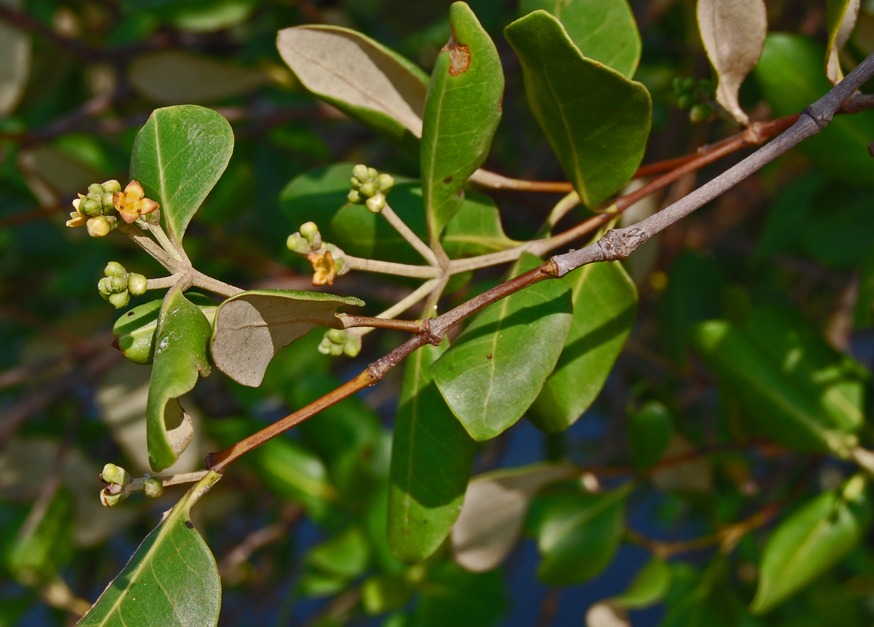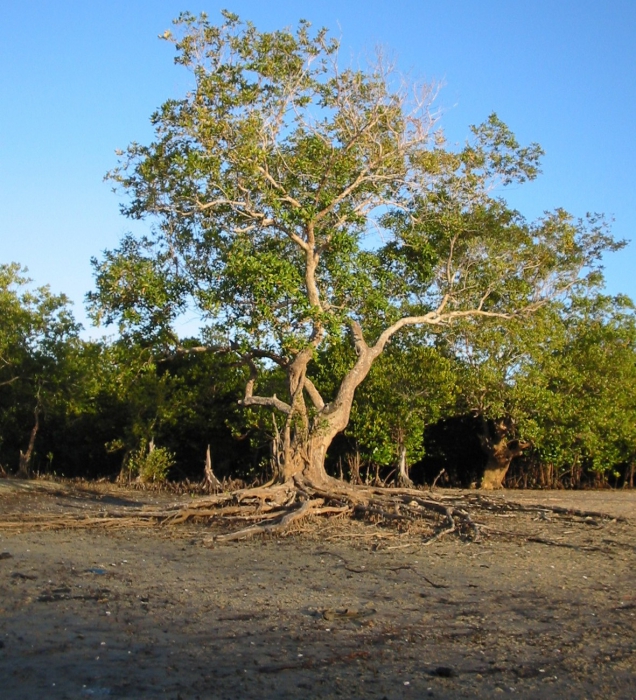Avicennia marina
Avicennia marina on the shores of Big Lake Malai, East Timor
Avicennia marina is a mangrove species in the genus Avicennia, which occurs from the east coast of Africa to Asia and Australia to Fiji. She has both in terms of longitude and the latitude the widest distribution of all mangrove species.
Characteristic of all the species are respiratory avicennia roots which protrude at regular intervals vertically from the bottom, and the exit from a saline fluid to the blades. Dries the liquid produced numerous salt crystals that are visible on the leaves.
- 5.1 Literature
- 5.2 Notes and references
Description
Appearance
Avicennia marina is an evergreen tree that is achieved under favorable conditions stature heights of 30 meters and wide canopy. Under less favorable conditions and at the edge regions of the range of the species grows shrub-like, for example, in the North Island of New Zealand.
Root system
From the base of the trunk several feet go a long, flat out running roots. This form (breathing roots), the vertical rise up to 30 centimeters in height and end in a very pronounced peak as with other Avicennia species at regular intervals pneumatophores. The breathing roots are rarely branched and have a corky surface. They are used to supply the root system with oxygen, which is not sufficiently present in the silt soil. In addition, growing roots are formed in the ground, which serve to anchor and nutrient uptake. These are slightly longer than the breathing roots and branch out. Avicennia marina sometimes also forms stilt roots, which is otherwise rare in Avicennia species.
Bark and wood
Avicennia marina has has a gray, scaly, covered with Korkporen, detaching bark, the yellowish- green spots. The timber does not form a growth rings, but has a band structure of the xylem and phloem - bands are separated by sclerenchyma. The number of rings is determined only by the diameter of the tree, and is independent of external influences. From the band structure can not be closed to the age of the tree.
The leaves are decussate. The petioles are up to three inches long, are yellowish hairs and furrowed. The leathery leaf blade is ovate and rounded at the tip. The veins are inconspicuous, the midrib protrudes on the underside of leaves. The top is smooth, the bottom covered with numerous small hairs that cause the slightly gray to olive green color. For the regulation of the salt budget are both at the top as well as undersides of the leaves salt glands that excrete a saline liquid. Dries the liquid form on the leaves salt crystals.
Flowers and Fruit
The flowers are in rispenähnlichen inflorescences, are radial symmetry, yellow - orange, fragrant and have diameters of up to six millimeters. The corolla is vierlappig and largely glabrous except for small glandular hairs. The stamens are short, a maximum of two millimeters long and not protrude from the flower. The stamens are about the same length as the stamens. The ovary is two to three millimeters long with a short, smooth pen. Pollination is by bees.
The fruit capsules have a diameter of two centimeters and a round to slightly oval shape. Germination of the seed is carried out already in the fruit, without the seedling leaves the fruit before it drops.
Distribution and habitat requirements
The range of the species extends from East Africa across the Red Sea along tropical and subtropical coasts of the Indian Ocean to the South China Sea. They are found on the coasts of Australia and the North Island of New Zealand, on islands of Polynesia and Fiji. The distribution area is located between 25 ° north and 38 ° south latitude.
Mangroves occur in tropical and subtropical coastlines. Your environment is characterized by the salt water, the tides, through the underground consisting of oxygen-poor mud and by high temperatures and high humidity. They are not dependent on salt water, but may also exist in arms of freshwater rivers. Avicennia marina is in a salt content corresponding to approximately half of the sea water, an optimum growth.
Avicennia marina is listed in the IUCN Red List as not at risk ( "Least Concern" ).
System
We distinguish several varieties, where there is strong overlap in the assignment. Genetic studies can be at least three different varieties:
- A. marina var marina is on the west coast of Australia and the west -lying areas. It differs from the other varieties by the larger corolla and calyx hairy.
- A. marina var eucalyptifolia on the north coast of Australia. She has more elongated leaves, a hairy calyx and a smaller Corolla.
- A. marina var australasica on the east coast of Australia and eastern areas with little hairy calyx.
Var marina
Var eucalyptifolia
Var australasica
The varieties marina and eucalyptifolia are genetically similar. The differences in favor of a separation of only about 200,000 years ago, at the variety australasica for a separation of about 2 million years ago. Deviations up to a factor of 20 is possible for both values . A separation already in the Cretaceous, however, is ruled out. The separation between var and var marina eucalyptifolia could be done in the Ice Age, when sea level by the weakening of a land barrier further east marina occurring variety of the further west eucalyptifolia separated. The influence of this barrier could be determined for different occurring in the sea species.
From the morphological point of view the following varieties are distinguished from Moldenke:
- A. marina var marina with a distribution area of East Africa across the Red Sea to Australia.
- A. marina var resinifera with compact inflorescences from two to twelve flowers, oblong- elliptic leaf blades with pointed up -sharpened apex. Their occurrence extends from Sumatra about Australia, the North Island of New Zealand, New Caledonia, New Guinea to the Philippines.
- A. marina var rumphiana with long petioles from 1.5 to 3 centimeters. The distribution area extends from Malaysia to New Guinea to the Philippines.
- A. marina var anomala with reduced inflorescences. The distribution area is limited to Queensland.
- A. marina var acutissima with particularly pointed leaf tips. The distribution area is limited to the vicinity of Mumbai.
The following further by Moldenke not recognized varieties are:
- A. marina var intermedia with a distribution area of Malaysia up to New Guinea and the Philippines. The variety is distinguished by the ovate - round Spreitenform and the short petioles of up to 2 millimeters in length and small fruits. In Moldenke this group is counted variety marina.
- A. marina var australis, the name is likely to have no taxonomic significance, but only reflect a geographical fact.
Use
The species has a wide variety of uses in traditional societies. From thick stems canoes are made. This because of its salinity resistant to insects wood is used for furniture and in shipbuilding. As firewood, it has not the best reputation, but is used because of its wide availability for this and for charcoal production.
At night the green wood is often used as an insect repellent because it burns slowly and with a lot of smoke, which keeps away mosquitoes. Also honey collectors make use of this property to open hives.
The flowers give off nectar that attracts bees. At least on the way New Zealand is used as a honey plant.






